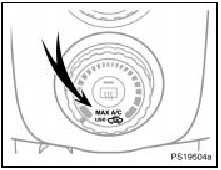 Toyota Yaris: Operating tips
Toyota Yaris: Operating tips
To cool off your Toyota after it has been parked in the hot sun, drive with the windows open for a few minutes.
This vents the hot air, allowing the air conditioning to cool the interior more quickly.
Make sure the air intake grilles in front of the windshield are not blocked (by leaves or snow, for example).
On humid days, do not blow cold air on the windshield. The windshield could fog up because of the difference in air temperature on the inside and outside of the windshield.
Keep the area under the front seats clear to allow air to circulate throughout the vehicle.
On cold days, set the fan speed to “high” for a minute to help clear the intake ducts of snow or moisture. This can reduce the amount of fogging on the windows.
When driving on dusty roads, close all windows. If dust thrown up by the vehicle is still drawn into the vehicle after closing the windows, it is recommended that the air intake selector be set to FRESH and the fan speed selector to any setting except “0”.
If following another vehicle on a dusty road, or driving in windy and dusty conditions, it is recommended that the air intake selector be temporarily set to RECIRCULATE, which will close off the outside passage and prevent outside air and dust from entering the vehicle interior.
Heating
For best results, set controls to:
Fan speed—Any setting except “0”.
Temperature—Towards WARM (red zone).
Air intake—FRESH (outside air).
Air flow—FLOOR.
Air conditioning—OFF.
For quick heating, select recirculated air for a few minutes. To keep the windows from fogging, select fresh after the vehicle interior has been warmed.
Press the “A/C” button on for dehumidified heating.
Choose floor/windshield air flow to heat the vehicle interior while defrosting or defogging the windshield.

Air conditioning
For best results, set controls to:
Fan speed—Any setting except “0”.
Temperature—Towards COLD (blue zone).
Air intake—FRESH (outside air).
Air flow—PANEL.
Air conditioning—ON.
For quick cooling, turn the temperature selector knob fully towards COLD and change the air intake selector mode RECIRCULATE.
Ventilation
For best results, set controls to:
Fan speed—Any setting except “0”.
Temperature—Towards COLD (blue zone).
Air intake—FRESH (outside air).
Air flow—PANEL.
Air conditioning—OFF.
Defogging and defrosting
The inside of the windshield.
For best results, set controls to:
Fan speed—Any setting except “0”.
Temperature—Towards WARM (red zone) to heat;.
COLD (blue zone) to cool.
Air intake—FRESH (outside air).
Air flow—WINDSHIELD
Turning the air flow selector to windshield position turns on the defogging function with the purpose of clearing the front view.
Vehicles with “A/C” button—
Press the “A/C” button for dehumidified heating or cooling. This setting clears the front view more quickly.
On humid days, do not blow cold air on the windshield—the difference between the outside and inside temperatures could make the fogging worse.
The outside of the windshield
For best results, set controls to:
Fan speed—Any setting except “0”.
Temperature—Towards WARM (red zone).
Air intake—FRESH (outside air).
Air flow—WINDSHIELD.
Turning the air flow selector to windshield position turns on the defogging function with the purpose of clearing the front view.
Vehicles with “A/C” button—
Press the “A/C” button for dehumidified heating or cooling. This setting clears the front view more quickly.
To heat the vehicle interior while defrosting the windshield, choose floor/windshield air flow.
 Instrument panel vents
Instrument panel vents
Side vents
Center vents
If air flow control is not satisfactory, check the instrument panel vents. The
instrument panel vents may be opened or closed as shown.
Side vents
Center ve ...
See also:
Refueling
Opening the fuel tank cap
Perform the following steps to open the fuel tank cap:
■ Before refueling the vehicle
Turn the engine switch off and ensure that all the doors and windows are closed ...
Instrument cluster overview
With tachometer
Instrument cluster overview
1. Service reminder indicators and indicator lights
2. Tachometer
3. Speedometer
4. Clock
5. Clock reset knob
6. Odometer and two trip mete ...
Rocker outer panel (CUT): Hatchback 3 Door
REPLACEMENT
REMOVAL
INSTALLATION
Temporarily install the new parts and measure each part of the new parts in accordance
with the body dimension diagram. (See the body dimension diagram) Inspe ...

